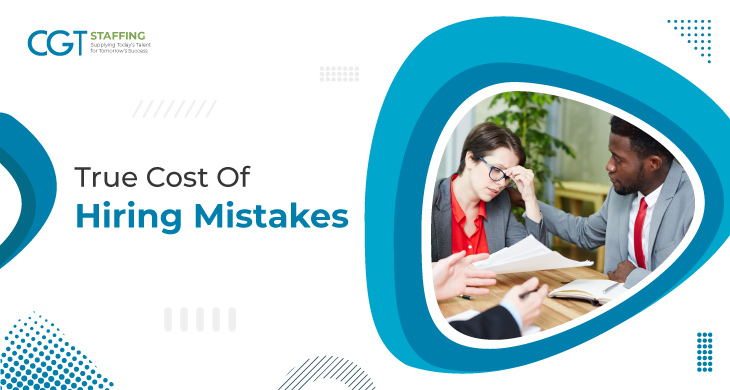Hiring the right employees is crucial for the success of any organization. However, making mistakes during the hiring process can have significant financial implications that often go unnoticed. In this blog post, we will delve into the hidden expenses associated with hiring mistakes, shedding light on the true cost that organizations bear when talent acquisition initiatives fall short.
Table of Contents
The Cost of Recruitment and Onboarding
The cost to review applications, conducting interviews, and negotiating terms adds to the overall HR expenses, and is not often properly quantified. When a hiring mistake occurs, these costs go down the drain and need to be spent again in the search for a replacement.
Staffing agencies are often engaged as a means of managing these internal expenses, which can multiply quickly as a result of employee turnover and insufficient vetting and hiring practices. As experts in personnel identification, agencies can markedly reduce these financial burdens by providing the right merger of talent and hiring need the first time.
The Impact on Performance and Productivity
When an unsuitable candidate is hired, it can have a detrimental effect on overall performance and productivity. According to research by the Harvard Business Review, a poor hiring decision can result in a loss of up to 80% of the individual’s annual salary due to decreased productivity and increased supervision requirements.
Additionally, the presence of an insubordinate employee can disrupt team dynamics, leading to reduced collaboration, increased conflicts, and a negative work environment. This not only affects the performance of the team, but also lowers employee morale and engagement, potentially resulting in even higher turnover rates.
Reputational Damage
In today’s interconnected world, word of mouth travels quickly, and negative experiences can damage a company’s reputation. If a business consistently makes poor hiring decisions, it can develop a negative reputation across the job market. This can deter top talent from considering future job opportunities with the company, hindering its ability to attract high-performing professionals.
Additionally, dissatisfied employees may share their negative experiences on public platforms, impacting the company’s employer brand and its ability to retain and attract talent.
Training and Development Costs
Hiring mistakes often require additional investment in training and development to bring the new hire up to speed. According to the Association for Talent Development, companies spend an average of $1,273 per employee on training and development annually. When a new hire fails to meet expectations or lacks the necessary skills, organizations must bear the cost of additional training and resources to rectify the situation.
Employee Turnover and Recruitment Costs
A poor hiring decision can lead to increased employee turnover, requiring organizations to unnecessarily reinvest in their own recruitment process. The turnover cost includes advertising, screening, interviewing, and onboarding expenses. The Work Institute’s 2020 Retention Report revealed that the average cost of turnover per employee is approximately 33% of their annual salary.
Turnover disrupts workflow, lowers team morale, and puts additional strain on existing employees, who need to fill in the gaps left by the departed individual. This results in increased stress levels, and low overall productivity.
Management Time and Resources
When a hiring mistake is made, managers are often required to invest additional time and effort to address the situation. They may need to provide extra guidance, supervision, or corrective action plans to improve the performance of an underperforming employee. The time spent managing such issues could have been better allocated to strategic initiatives and other important tasks. According to a report by HR.com, managers spend an average of 13% of their time dealing with underperforming employees. This diversion of managerial resources can hinder organizational growth and result in missed opportunities.
Employee Turnover
Hiring mistakes can lead to employee dissatisfaction and, ultimately, increased turnover rates. High turnover rates not only disrupt workflow and team dynamics but also impose significant financial burdens on an organization. The cost of replacing an employee can range from 16% to 213% of their annual salary, depending on the industry and position (Work Institute, 2021). These costs include recruitment, training, onboarding, and lost productivity during the transition period. A company with a high turnover rate is likely to face increased expenses and reduced profitability.
Legal and Compliance Costs
In some cases, hiring mistakes can lead to legal and compliance issues. For example, if an employee is found to be engaging in discriminatory behavior or violating Labor laws, organizations may face legal consequences, including fines, lawsuits, and damage to their reputation.
To mitigate such risks, it is essential to have a robust performance appraisal process in place, providing regular feedback and addressing any concerns promptly. This ensures that potential issues are identified early on, and appropriate actions are taken to prevent legal complications.
